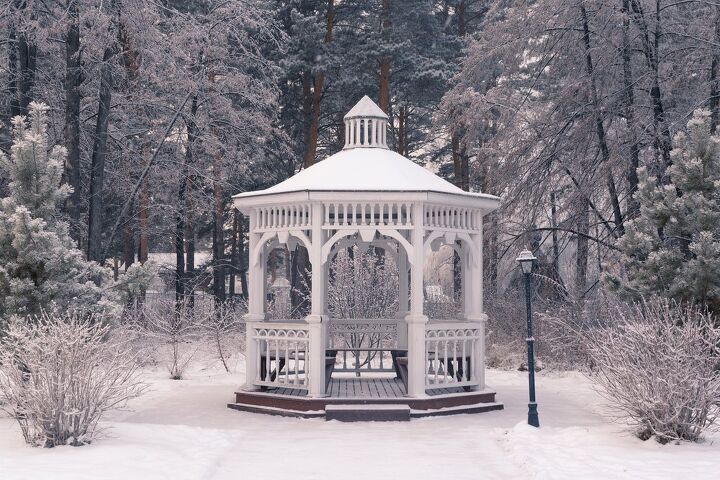How To Protect A Gaezbo In The Winter: 7 Quick Tips

A gazebo serves a lot of purposes for homes and gardens, as it has for the past 5000 years. It serves as beautification, an open outdoor space for multiple activities, an intimate setting for a date, and even for events such as weddings.
This means that aside from the cost of creating a gazebo, there are obviously other reasons why you would want to protect your gazebo in the winter.
To protect your gazebo during the winter, begin by tracking the snow accumulation on your gazebo’s roof. Next, set up a heating cable onto the roof of the gazebo. Place a gazebo cover on your gazebo to avoid any winter or harsh weather. Finish by weather and weatherproofing your gazebo.
The value this historical antique provides transcends times. Just like a 70s fireplace, it never goes out of fashion or style, and every day there are new ways to make the most of your gazebo.
This article will ensure you never have to ask the question “how to protect a gazebo in the winter” ever again.
Hire A Professional
The fact that you own a Gazebo doesn’t make you a professional installer/maintainer. You most likely hired a professional to help you with the installation.
To protect your gazebo during winter, it is paramount you invite a specialist to take a look at your gazebo and offer professional guidance on how you can best protect it.
Yes, that will cost you a few bucks, but it is more efficient. However, if you are looking to save more with DIY, then you are in luck. That is why we are here to provide you with valuable information you don’t have to pay for.
Continue reading to learn how you can protect your gazebo all by yourself.
Insure Your Gazebo
A Gazebo cost between the ranges of $500-20,000. Totally worth the value it provides for your home. However, it isn’t common practice to insure your gazebo. If you can spend up to $20,000 on your gazebo, you certainly can afford to make sure it is insured.
This will ensure you don’t have to pony up a cent should your gazebo ever get damaged from winter or any other external factor.
Maintain Your Gazebo
Like every other thing with value, the gazebo needs adequate maintenance. Checking your gazebo as often as once a week for anything that might be wrong will not only protect it when it’s winter but also increase its overall life span.
Maintenance could be discoloration happening on the walls, a loose screw, a broken ceiling, dirt build-ups and debris on the Gazebo canopy, or anything out of the ordinary. Ensuring your gazebo is in perfect shape before and during winter will ultimately protect your antique and increase its lifespan.
Track Snow Accumulation on Your Gazebo’s Roof
Snow accumulation in your Gazebo roof will lead to caving or a distorted roof. Tracking the snow build up on the Gazebo roof is how you stay on top protecting your gazebo. Once you feel the build-up is too much, ensure to clean.
While this exercise can be dangerous, exercising patience and equipping yourself with the right tools can safely help you get the job done.
Use A Heating Cable
Heating cables are quite expensive to manage. However, what wouldn’t you do for precious gazebo? Setting up a heating cable on the roof of your gazebo will help make sure you have no ice or snow buildup stuck on the roof.
The typical cost of purchasing and setting up a roof heating cable ranges from $1500 to $5000 depending on the size. That’s not all.
A good cable heater will also add at least 20% to your electricity bill. Since winter only lasts 90 days or so, you shouldn’t worry about spending so much on your electricity. Ensuring you only turn on your heating cables when you have plenty of snow buildup on your gazebo will help you save money on electricity.
Use Gazebo Covers
Gazebo covers are a cheaper alternative to using heating cables. Some Gazebo covers give you the ability to cover your antique from the roof to the last pillar. However, this will affect the beauty of your gazebo. Not a valid choice if you want to retain the elegance of your gazebo.
Also, covers doesn’t just protect your gazebo from the harsh winter weather; it can also provide a place of warmth for any purpose you will need your gazebo for during the winter.
As a rule of thumb, always have the exact measurement of your gazebo before proceeding to purchase a cover.
Water & Weatherproof Your Gazebo
Most Gazebo manufacturers claim their products are waterproofed. However, the reality can be a little different, especially for gazebos at the lower market cap.
If you are new to the use of the gazebo, you probably aren’t sure if your gazebo is waterproofed. If you are yet to get one, ensure to carry out research on the most durable materials for a Gazebo instead of throwing thousands of dollars on the biggest market deal.
Here is how you can tell if your gazebo is not waterproofed or durable:
- Single sheet of polyester with no lining or other protection
- No water-resistant chemical treatment of the canopy
- No extra protection of seams and stitches with sealant
- Frames that aren’t powder-coated
How to Weatherproof Your Gazebo
If your gazebo sold as weatherproof, you can always add water-resistant chemicals yourself. The truth is, even waterproof items will wear out in time. So even if it was originally waterproof when you bought it, ensure to reapply waterproof chemicals after a couple of years.
Typically, I recommend the use of Fabsil. Fabsil is a highly effective silicone-based water repellent treatment for all kinds of outdoor kit. It will bond to a wide range of fabrics, including canvas, cotton, polyester and nylon, producing a strong, waterproof barrier against rain and snow.
To apply, simply take off the canopy from its frame and set it on a flat surface. Clean off every debris and dirt, and then spray on the Fabsil using the manufacturer’s instructions.
Types of Gazebo To Be Waterproofed
Gazebos with these features will be more water-resistant than others. If you are looking to replace your gazebo or getting one for the first time, this is what to look out for.
Lined Polyester
Lined polyester is more efficient than a single polyester, which is often used on low-cost Gazebo canopies. Although all polyester offers a certain level of waterproof, lined polyester offers considerably higher protection against water and other elements. Single polyester absorbs a considerable amount of water, which can cause leaks.
Waterproof Coatings
Waterproof chemicals such as Fabsil make the difference between a normal polyester canopy and a one hundred percent waterproof canopy. Ensuring your canopy is laced with a waterproof coating is how you keep your Gazebo canopy safe during winter and other wet seasons.
Sealed Seams
Gazebo canopies tend to be vulnerable to leaks in areas with stitches. Always ensure that sealed seams are used on any stitch hole.
Rust Protection
Overlooking the weatherproofing of the gazebo’s frame is a common mistake. Frames will rust when they are not weatherproof, rendering the gazebo unusable.
Steel and aluminum frames can be susceptible to rusting if they’re not properly treated. Always look for powder-coated frames: this involves covering the frame with a polyester or epoxy powder, which is heated to fuse into a protective layer over the metal.
The Bottom Line
Protecting an asset such as the gazebo in winter takes time, preparations, and knowledge.
By considering the tips and information in this guide, you’ll be able to enjoy your gazebo for years to come!

We are a team of passionate homeowners, home improvement pros, and DIY enthusiasts who enjoy sharing home improvement, housekeeping, decorating, and more with other homeowners! Whether you're looking for a step-by-step guide on fixing an appliance or the cost of installing a fence, we've here to help.
More by Upgraded Home Team












![10 Best Zero Turn Mowers – [2022 Reviews & Ultimate Buyer's Guide]](https://cdn-fastly.upgradedhome.com/media/2023/07/31/9070522/10-best-zero-turn-mowers-2022-reviews-ultimate-buyer-s-guide.jpg?size=350x220)














